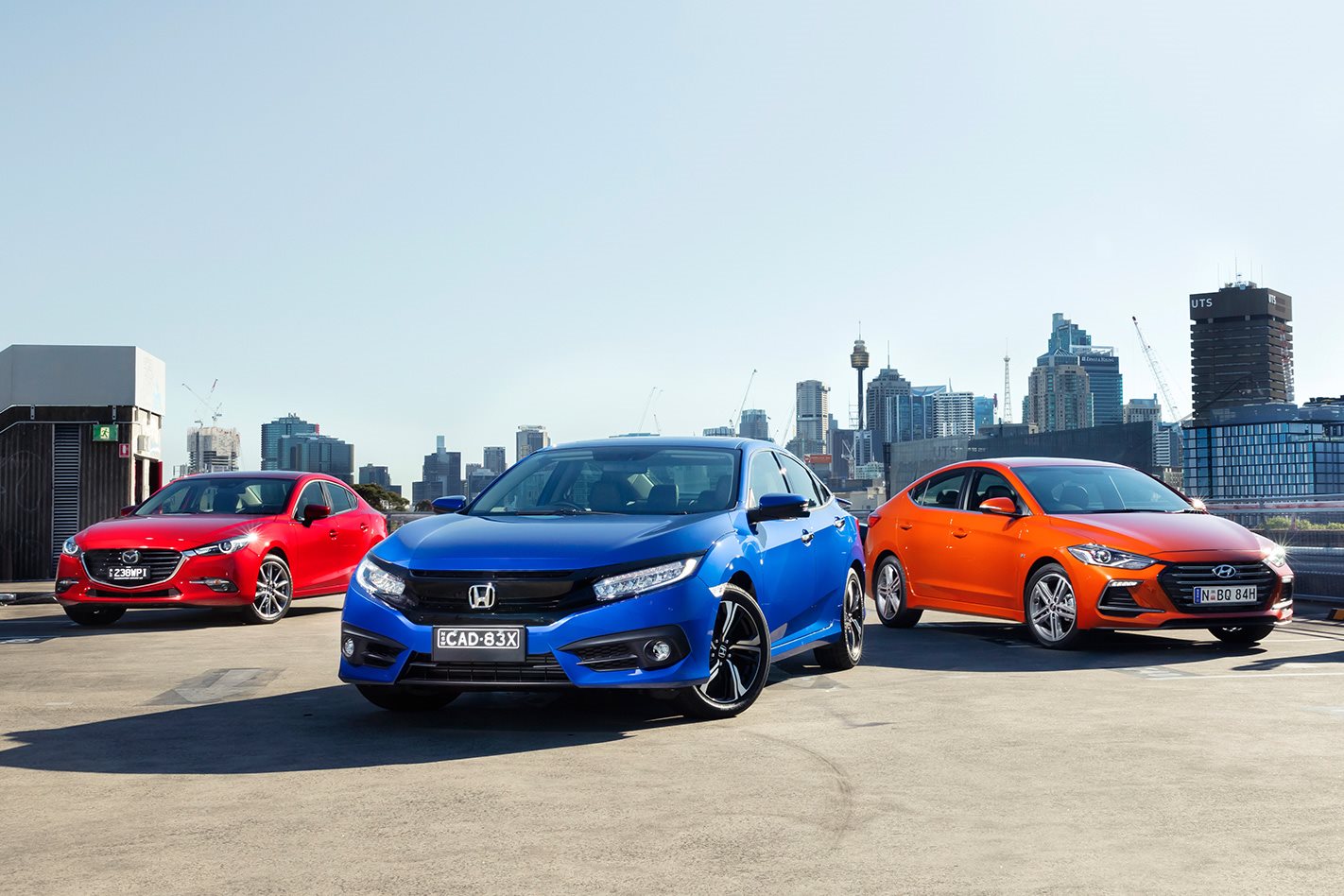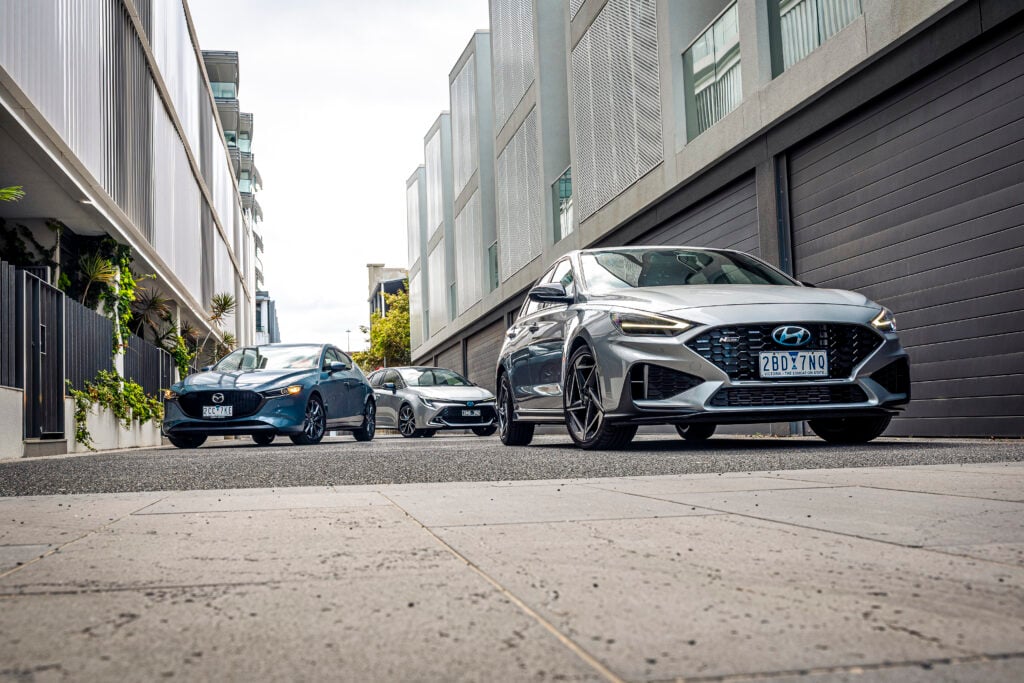Lukewarm? Not on your life. This trio proves that small sedans need not be dull econoboxes.
Can’t wait to see the final scores? Jump to the verdict now.
Remember when a zero-to-100km/h time in the seven-second bracket was quick?
I mean really quick? In the ’80s you needed either plentiful displacement or a turbo to get there, and in the Noughties a proper hot hatch or a home-grown warm sedan with at least six pistons under the bonnet.
Now that the domestic four-door is living on borrowed time, what will value-focused sedan buyers turn to if they like performance with their boot? Possibly a Honda Civic RS, Mazda 3 SP25 or Hyundai’s freshly baked Hyundai Elantra SR Turbo.
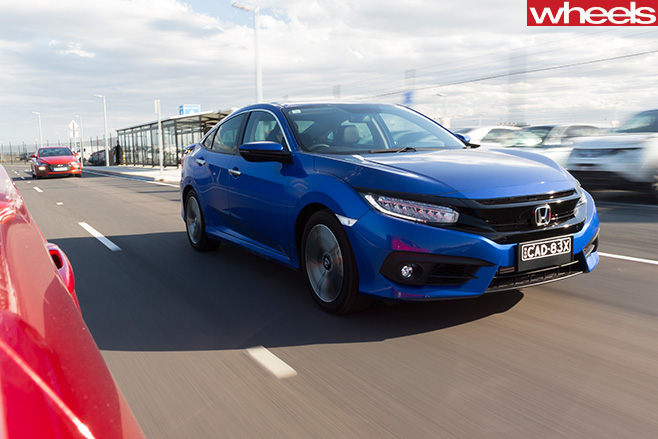
This is no ordinary sedan-warming, however. Gone is the boggo Elantra’s torsion-beam rear suspension and underwhelming 112kW 2.0-litre atmo four, replaced by a brand new multi-link independent rear, a seven-speed dual-clutch auto (or a six-speed manual if you appreciate the art of changing gears) and a 150kW 1.6-litre direct-injection turbo four pinched from the Veloster SR coupe.
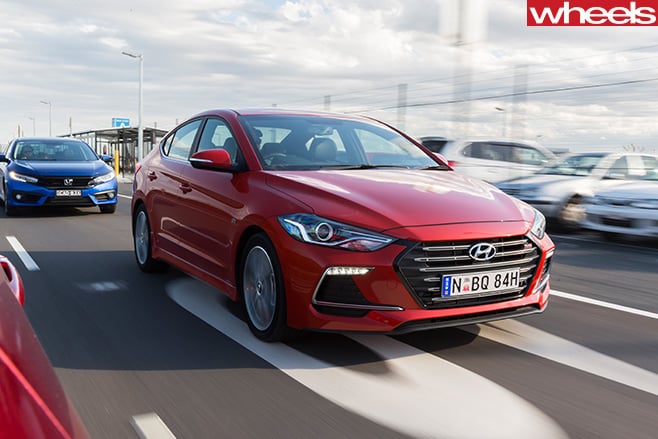
Despite the goodness lurking within, the warm sedan category is hardly a hot-bed of Snapchat-worthy eye candy. Chief rival for the $31,290 Elantra SR dual-clutch is Honda’s bodykitted $31,790 Civic RS, complete with the Japanese brand’s first mainstream forced-induction donk since the City Turbo, though producing the same 127kW as it does in lesser Civics, slugged with a one-transmission-fits-all CVT unlikely to attract enthusiasts.
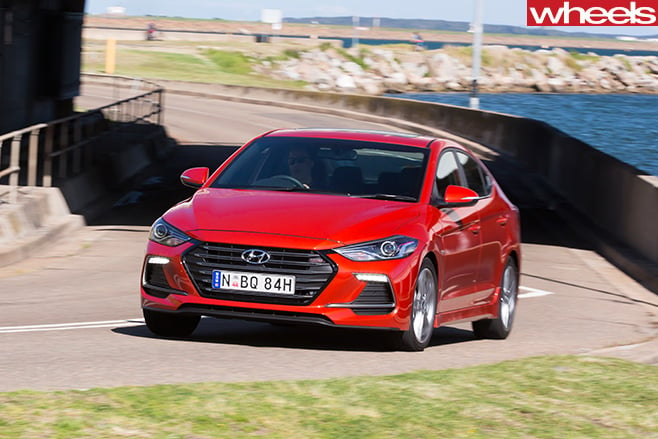
The immensely popular Mazda 3 SP25, now in its third generation, has crafted itself an enviable (and deserved) premium-mainstream image over the past 13 years. Recently updated with some new trim finishes, improved refinement and the addition of G-Vectoring Control (GVC) to enhance its reputation as a driver’s car, this SP25 is as aspirational as warm sedans get. Especially the range-topping $35,490 Astina with six-speed SkyActiv-Drive auto, which mirrors the $31,990 SP25 GT for mechanical spec, but loads on the trinkets for a class-busting level of spec.
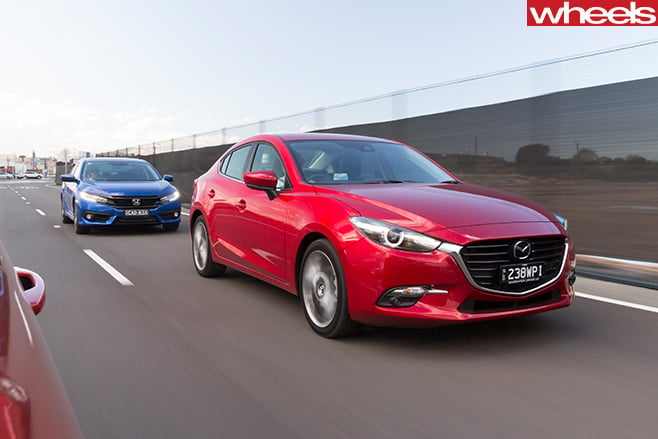
While the SP25 can’t quite match its boosted rivals at the strip (clocking 7.7sec to 100km/h and a 15.5sec standing 400m time), its drivetrain is deliciously responsive. Sweetly spirited and blessed with immaculate gear changes, the SP25 has an effervescent personality that frequently compensates for its ultimate lack of muscle compared to the grunty Elantra.

On paper, the new turbo Civic doesn’t quite have the Mazda’s measure. Less power (127kW), a lower torque threshold (220Nm from 1700-5500rpm compared to 250Nm at 3250rpm) and a CVT transmission imply lazier, less-flustered performance that’s all about wafting. And that’s mostly true. But there’s a disconnect between the Honda’s almost raucous engine and its economy-focused transmission.
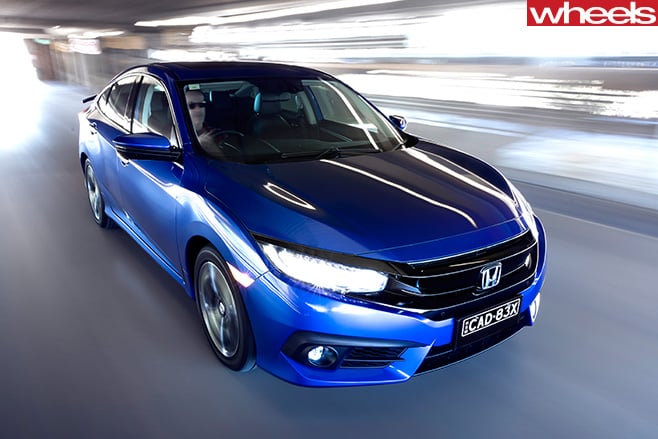
But it’s the drivetrain’s ‘rubber band’ effect that undermines the new Civic’s excellence. Nail the accelerator to plug a gap in traffic and you get a combination of engine and transmission lag before the drivetrain finds boost. Then, if you quickly lift your right foot, there’s a delay before the Civic lets go of both revs and throttle, in an almost reverse effect. Shifting the Civic’s gearlever into ‘S’ minimises lag, but the rubber-band feeling remains.
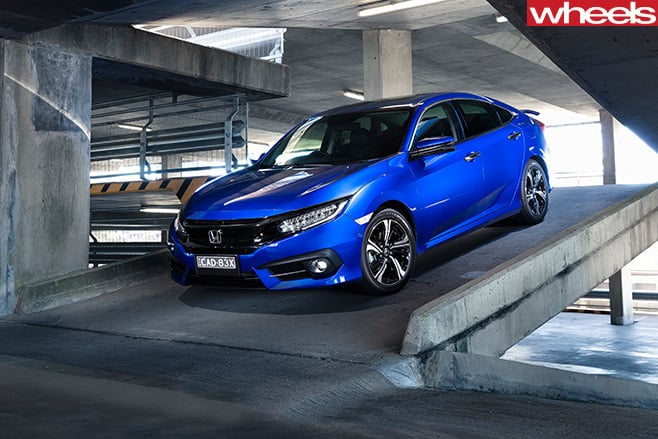
It does have its good points. On hilly country roads, Civic’s drivetrain is excellent – quiet, torquey and effortless – but the more you ask of it, the greater its deficiencies. You know what would (mostly) save it? A manual gearbox, with which Honda used to excel.

Off the line, it momentarily pauses before hitting its stride, meaning the sixes and 14s this drivetrain is capable of simply don’t materialise. Once on the move, though, the Elantra SR is a wolf dressed in a sheep’s coat with a pair of Onitsuka trainers.
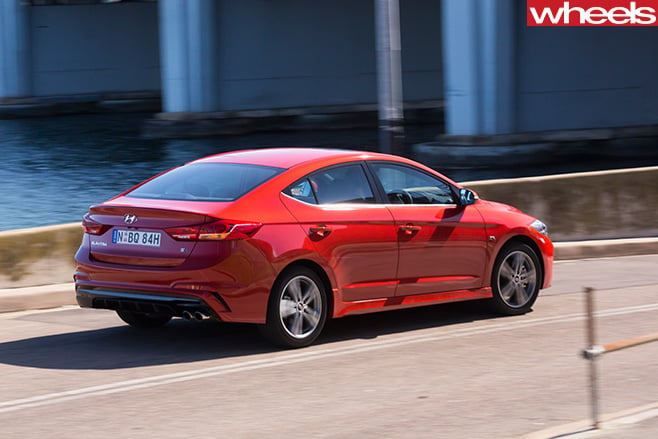
Much as Hyundai’s seven-speed DCT is generally excellent at doing what it does, we noticed the occasional hiccup. A fluffed shift here and a dose of neutral before settling revs and discovering a ratio proves that VW and Ford aren’t alone in not quite matching torque-converter-auto slickness with their dual-clutch transmissions. But the Elantra ’box showed no signs of fatigue in hard driving, and neither did its upsized brakes, performing two 34.7m stops from 100km/h in succession.
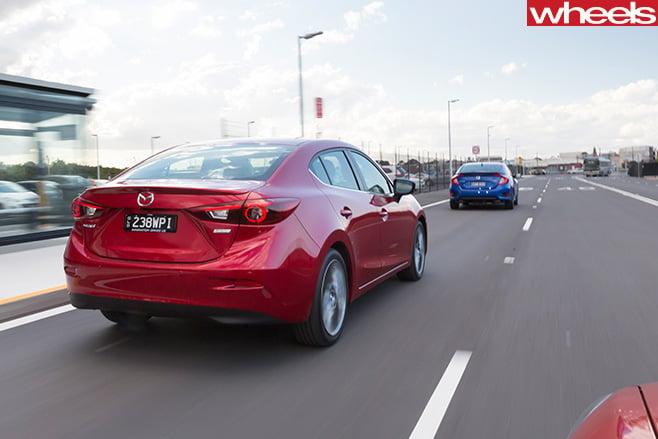
The result is a warm sedan that gets better the longer and harder you drive it. Steering connection could be crisper at straight ahead, and off-centre response a bit more decisive, but once you have a quarter-turn of lock wound on, the Elantra SR’s chassis really hooks into corners. It feels fluid and progressive as it adjusts its balance, and once you’re at (or beyond) that quarter-turn wheel position, the Elantra squats onto its outside rear tyre and fires itself through bends carrying serious speed. It’s beautifully neutral but also impressively adjustable, and if you pin the nose into a tight corner under brakes then lift off, it’ll even serve up some oversteer, all without spoiling its dynamic flow. And (incredibly for a Korean car) without disturbing its benign and subtle stability control.

Up to about seven- or eight-10ths, the Civic is arguably sportier. There’s a connection between its fast-geared steering and the alertness of its chassis that makes it feel more naturally poised than the Hyundai. It wants to dive towards apexes and delivers terrific adjustability from its rear end. You sit low and ensconced in the Honda, too, with a proper sporty driving position and a marvellous view ahead, making fast country running an undeniable pleasure. But at the outer reaches it’s a very close fight with its Korean nemesis for the driver’s-car title.

The Mazda’s drivetrain is much more linear and entertaining than the Honda’s, though its dynamics tread a different path. Despite the subtle enhancements achieved via G-Vectoring Control, the 3 feels relatively disinterested much of the time. Steering inputs from straight ahead at steady speeds simply don’t achieve the instant poise, precision and response that define the new Civic, but if you corner the SP25 harder, it brings its back end into play and suddenly becomes the sporty sedan everyone assumes it is.

The Honda shines in this department, owing to the most supple ride of the group and the least road noise. It can be punished over rough surfaces and all you get in return is some rocking around of its passengers, all of whom are lounging in the most accommodating interior here. The Civic’s strong suit is definitely making a determined stab at a rolling country road. With its chassis engaged and the best aspects of its torquey donk and infinitely geared transmission deployed, the Civic RS is a brilliant mile-eater.
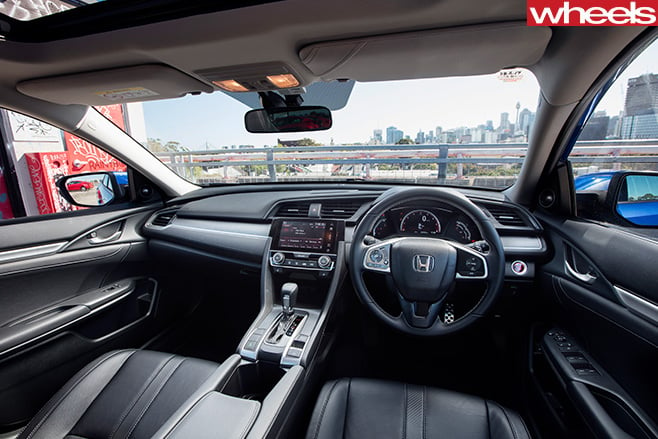
Alongside the other two, the Mazda 3 feels smaller and narrower. With styling taking precedence over packaging (to the benefit of everyone’s eyes – the SP25 is easily the most elegantly styled car here), the Mazda can’t hope to deliver taxi-like space in the rear, or the Honda’s expansive aspect up front. Its seats are also not quite right, particularly the front pair, and why does this $35K range-topper only get height adjustment for the driver when a base Volkswagen Golf or 308 offer it on both front seats? Ditto a driver-only one-touch power window.
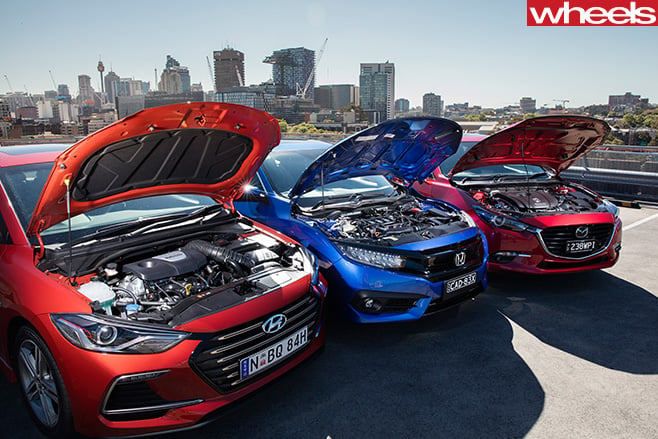
The Elantra and Civic are somewhat harder to separate. The Oz-tuned Hyundai is more overtly sporty, with a really fun chassis and loads of meaty, accessible grunt. But it does look a bit like someone’s dad in a race suit, and it doesn’t have the holistic design approach of the Honda. You can tell the Elantra SR is a deeply conservative car that’s been given the Cinderella sporting treatment whereas the new-gen Civic was designed like that from the get-go.

If it were us, the solution is simple: either an Elantra SR (manual or dual-clutch) with optional dealer-fit 18s, or a lower-spec 1.5 turbo Civic (the $27,790 VTi-L) that drives exactly the same as the RS but without the implication of an inappropriately applied badge.
Verdict
HONDA CIVIC RS
Price as tested: $31,790/As tested $32,365 *Includes metallic paint ($575)
NCAP rating: 5 stars (US)
Fuel economy: 7.5L/100km (test average)
Acceleration: 0-100km/h: 7.4sec (tested)
Plus: Fine chassis; quick steering; polished ride; vast interior; driving position
Minus: CVT spoils the fun; turbo donk’s raucousness and lack of linearity
Verdict: 7.5/10
HYUNDAI ELANTRA SR
Price as tested: $27,940 *Includes metallic paint ($450)
NCAP rating: 5 stars (Aus)
Fuel economy: 7.9L/100km (test average)
Acceleration: 0-100km/h: 7.0sec (tested)
Plus: Mid-corner balance and pace; tons of grip; strong engine; slick gearbox
Minus: Core engineering not as holistic as the Honda’s; bland core design
Verdict: 7.5/10
MAZDA 3 SP25 ASTINA
Price as tested: $30,940 * Includes metallic paint ($450) and ‘Skyview’ glass roof ($1500)
NCAP rating: 5 stars (Aus)
Fuel economy: 0-100km/h: 7.7sec (tested)
Acceleration: 0-100km/h: 10.0sec (tested)
Plus: Peachy drivetrain; excellent quality; hard-driving handling; styling; image
Minus: Pattery ride; not-quite-there seats; much less room than its rivals
Verdict: 7.0/10

